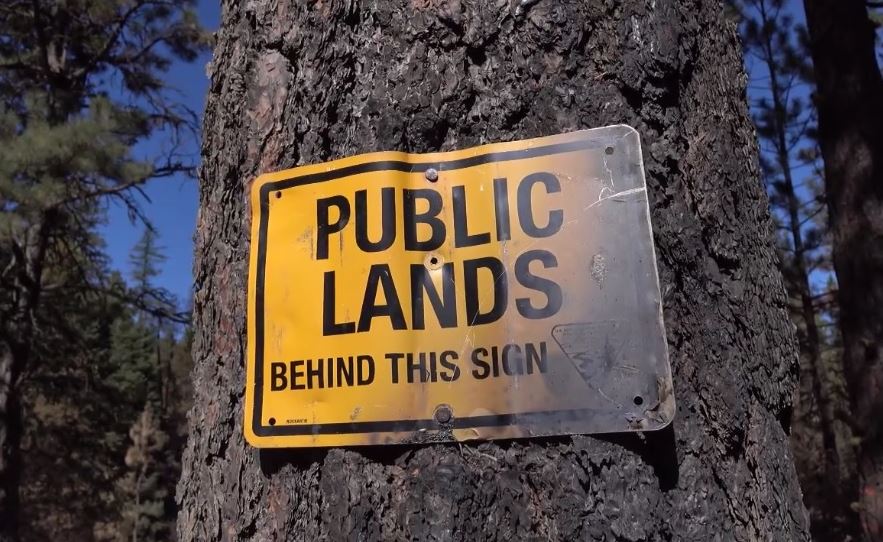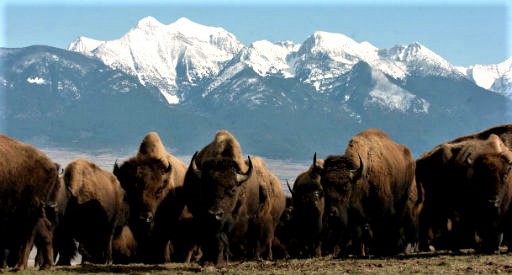When someone acquires a solid understanding of legislative jurisdiction on federal lands, you will learn that no branch of the Federal Government or appointed bureaucrat; including Congress, Secretary of Interior, or the President of the United States, can take unilateral action and obtain/adopt a State’s legislative jurisdiction.
Brandon Siegfried
How the BLM Turned Federally Managed Public Lands Into an Unconstitutional Federal Enclave
When one person can make the rules and laws over a land, it is called an autocracy or a monarchy (King or Queen). In the case of the Secretary of Interior, they are appointed by the President and according to President Trump, the Secretary of Interior is the largest “Property Manager” in the United States (2-20-2020, Trump Rally in Colorado Springs, CO). The Property Clause of the Constitution, Art IV, Clause 3, Section 2, declares “The Congress shall have power to dispose of and make all needful rules and regulations respecting the territory or other property belonging to the United States”. However, in 1976 Congress passed the Federal Land Policy and Management Act (FLPMA) and Section 303 allows the Secretary of Interior to write laws over all federal lands with unilateral action. These Title 43 Code of Federal Regulations (CFR) pertain to about 1/3 of the land mass of the United States. CFR is very important to understand, per Barbara Bavis, “How to Trace Federal Regulations”, Library of Congress, 2014, https://blogs.loc.gov/law/2014 , “Our patrons at the Law Library of Congress frequently ask us for assistance in investigating the origins and statutory authority of federal rules and regulations. And no wonder–regulations are important to understand, because they have the force and effect of law just as federal statutes do, though they are not issued by Congress. Instead, rules and regulations are created by a federal body such as an agency, board, or commission, and explain how that body intends to carry out or administer a federal law. In fact, these rules and regulations can often affect our everyday lives even more directly than statutes…”. As a result of FLPMA, the Secretary of Interior was basically given the power to write rules/laws over 640 million acres of federal public lands lands, all of which is located within the boundaries of various states. To research the rules/ laws implemented by the Secretary of Interior, reference Title 43 in the eCFR.
What happens if the Secretary of Interior does not understand legislative jurisdiction on federally owned lands? Could a CFR regulation be recorded, that is unconstitutional? Absolutely, and this article will define that scenario. Here is an example of federal agency ignorance. Each year the Department of Interior (DOI) publishes the Public Land Statistics Book. Did you know that for at least 63 years (1951 to 2013), the DOI’s annual Public Lands Statistics book incorrectly claimed to have “Exclusive Jurisdiction” over all federal BLM lands? This was amended a few years ago because an informed individual who studied the federal jurisdiction reports on this web site, submit a FOIA request and received this “unintended misuse” response from the BLM. For at least 63 years the Federal Government claimed all BLM lands were a federal enclave under the exclusive jurisdiction of the Federal Government and no one knew better within the entire BLM agency. It’s as if the federal jurisdiction reports on this web site had been buried and forgotten. One can see based on the FOIA response that the BLM still claims “jurisdiction” over all federal lands, even though they have received no form of legislative jurisdiction from the states over 95% of federally manged lands, this will be explained in detail, within this article.
Let’s take this discussion one step further and dive into federal legislative jurisdiction on our federally owned, Bureau of Land Management (BLM) public lands. In the remainder of this well referenced article, we will discuss how it appears the vast majority BLM federally managed public lands have become unconstitutional federal enclaves, subject to federal enclave law, despite the fact that the Federal Government has obtained no form of legislative jurisdiction over the majority of BLM lands. See DOJ Section 1630 regarding 18 U.S.C. § 7 “any property under the exclusive or concurrent jurisdiction of the United States is subject to these federal enclave law”.
According to page 895 of the 1962 GSA Federal Inventory Report on Jurisdictional Status of Federal Areas within the State 95% of federally managed public lands are held in a Proprietorial Interest Only and only 4% of federally managed public lands are held in Exclusive or Concurrent Jurisdiction. Federal public lands that are under the Exclusive or Concurrent Jurisdiction of the Federal Government are subject to federal enclave laws (18 USC 13 – Assimilative Crimes Act), which gives the federal government the authority to “adopt” or “assimilate” state laws in the absence of federal laws, thus making the federal lands in question a Federal Enclave. Two examples of this state cession process utilized to establish constitutional federal enclaves in Colorado; are Rocky Mountain National Park which became an Exclusive Jurisdiction federal enclave in 1929 and the Colorado National Monument (Mesa County – Grand Junction, CO) which became a concurrent jurisdiction federal enclave in 1984. Each link on the two above mentioned federal enclaves provides the constitutionally required state cession by the elected state legislature and the official federal recorded acceptance of that state cession, which has been required since 1940, per federal law 40 USC 3112.
What is a Federal Enclave?
In United States law, a federal enclave is a parcel of federal property within a state, that is under the Special Maritime and Territorial Jurisdiction of the United States. DOJ Criminal Resource Manual 1630 — 18 U.S.C., states “any property under the exclusive or concurrent jurisdiction of the United States is subject to these federal enclave laws… There are three methods by which the United States obtains exclusive or concurrent jurisdiction over federal lands in a state: (1) a state statute consenting to the purchase of land by the United States for the purposes enumerated in Article 1, Section 8, Clause 17, of the Constitution of the United States; (2) a state cession statute; and (3) a reservation of federal jurisdiction upon the admission of a state into the Union. See Collins v. Yosemite Park Co.”
When someone acquires a solid understanding of legislative jurisdiction on federal lands, you will learn that no branch of the Federal Government or appointed bureaucrat; including Congress, Secretary of Interior, or the President of the United States, can take unilateral action and obtain/adopt a State’s legislative jurisdiction. This is well defined in the 1957 GSA federal report titled, Part II Interdepartmental Committee for the Study of Jurisdiction over Federal Areas within the States, Chapter 3 (Acquisition of Legislative Jurisdiction), Page 46 it defines the following: “Constitutional consent –The Constitution gives express recognition to but one means of Federal acquisition of legislative jurisdiction– by State consent under article I, section 8, clause 17…. No federal legislative jurisdiction without consent, cession, or reservation. It scarcely needs to be said that unless there has been a transfer of jurisdiction (1) pursuant to clause 17 by a Federal acquisition of land with State consent, or (2) by cession from the State to the Federal Government, or (3) unless the Federal Government has reserved jurisdiction upon the admission of the State, the Federal Government possesses no legislative jurisdiction over any area within a State.”
What are the 4 Types of Legislative Jurisdiction on Federal Lands?
Now that you understand how the Jurisdiction Clause, Art 1, Sect 8, Clause 17 (aka Enclave Clause) regulates the acquisition of federal jurisdiction on federally managed public lands within the states, lets define the 4 types of jurisdiction as defined in these federal documents linked below. These documents are available at www.publiclandjurisdiction.com , which is by far, the best guide online, at helping define this topic. Be sure to share it, with your elected officials including your County Sheriff if you live in area that has BLM and USFS lands. Most Sheriffs, State Attorneys, and elected officials have no educational background on the topic. This is largely the result of it not being taught in criminal justice programs in colleges and law schools. The four types of legislative jurisdiction:
- Exclusive Legislative Jurisdiction (Federal Enclave)- Exclusive Jurisdiction is the term applied when the Federal Government possesses, by whichever method acquired, all of the authority of the State, and in which the State concerned has not reserved to itself the right to exercise any of the authority concurrently with the United States.
In the 1956 federal GSA report on this web site, titled, Part I, Interdepartmental Committee for the Study of Jurisdiction Over Federal Areas within the States, Chapter III, Page 13 declares: ” The term Exclusive legislative jurisdiction as used in this report refer to the power “to exercise exclusive legislation” granted to the Congress by article I, section 8, clause 17, of the Constitution, and to the like power, which may be acquired by the United States through cession by a State, or by a reservation made by the United States through cession by a State, or by a reservation made by the United States in connection with the admission of a State into the Union. In the exercise of such power as to an area in a State the Federal Government theoretically displaces the State in which the area is contained of all its sovereign authority, executive and judicial as well as legislative.
- Concurrent Legislative Jurisdiction (Federal Enclave)- Concurrent Jurisdiction is the term applied in those instances wherein granting to the United States authority which would otherwise amount to exclusive legislative jurisdiction over an area, the State concerned has reserved to itself the right to exercise, concurrently with the United States, all of the same authority.
In the 1957 federal GSA report, titled, Part II, Interdepartmental Committee for the Study of Jurisdiction Over Federal Areas within the States, Ch. 3 (Acquisition of Legislative Jurisdiction), Pages 47-48 declare: “NECESSITY OF STATE ASSENT TO TRANSFER OF JURISDICTION TO FEDERAL GOVERNMENT: Constitutional consent.–The Federal Government cannot, by unilateral action on its part, acquire legislative jurisdiction over any area within the exterior boundaries of a State. Article I, section 8, clause 17, of the Constitution, provides that legislative jurisdiction may be transferred pursuant to its terms only with the consent of the legislature of the State in which is located the area subject to the jurisdictional transfer. As was indicated in chapter II, the consent requirement of Article I, Section 8, Clause 17, as intended by the framers of the Constitution to preserve the States’ jurisdictional integrity against Federal encroachment.”
- Partial Legislative Jurisdiction– Partial Jurisdiction is the term applied in those instances wherein the Federal Government has been granted for exercise by it over an area in a State, certain of the State’s authority, but where the State concerned has reserved to itself the right to exercise, by itself or concurrently with the United States, other authority constituting more than merely the right to serve civil or criminal process in the area (e.g., the right to tax private property).
- Proprietorial Interest Only– Proprietorial Interest Only (a.k.a. proprietary jurisdiction) the Federal Government has acquired no form of legislative jurisdiction over the federally lands in question. Those instances wherein the Federal Government has some right or title to an area in a State but has not obtained any measure of the State’s authority over the area. In applying this definition, recognition should be given to the fact that the United States, by virtue of its functions and authority under various provisions of the Constitution, has many powers and immunities not possessed by ordinary landholders.
In the 1956 federal GSA report titled, Part 1, Interdepartmental Committee for the Study of Jurisdiction Over Federal Areas within the States, Chapter IV, Page 21 defines Proprietorial Interest Only as: “Where the Federal Government has no legislative jurisdiction over its land, it holds such land in a proprietorial interest only and has the same rights in the land as does any other landowner. In addition, however, there exists a right of the Federal Government to perform the functions delegated to it by the constitution without interference from any source…. Also, the Congress has special authority, vested in it by article IV, section 3, clause 2, of the Constitution, to enact laws for the protection of property belonging to the United States. Subject to these conditions, in the case where the United States acquires only a proprietorial interest, the State retains all the jurisdiction over the area which it would have if a private individual rather than the United States owned the land. However, for the reasons indicated, the State may not impose its regulatory power directly upon the Federal Government nor may it tax the Federal land.”
Free Range Report
Thank you for reading our latest report, but before you go…
Our loyalty is to the truth and to YOU, our readers!
We respect your reading experience, and have refrained from putting up a paywall and obnoxious advertisements, which means that we get by on small donations from people like you. We’re not asking for much, but any amount that you can give goes a long way to securing a better future for the people who make America great.
[paypal_donation_button]
For as little as $1 you can support Free Range Report, and it takes only a moment.



